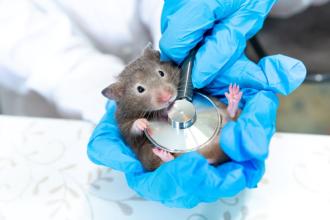
The United States signed the Animal Welfare Act (AWA) into law on August 24, 1966. This Federal law regulates the treatment of animals in research, teaching, testing, exhibition, transport, and by dealers. USDA, APHIS, Animal Care enforces the Act.
Since its original passage in 1966, lawmakers have amended the AWA numerous times. The AWA's 1985 amendment, 'Improved Standards for Laboratory Animals Act,' established the National Agricultural Library’s Animal Welfare Information Center (AWIC). AWIC provides current and historical information on the AWA to help people understand the law and its requirements.
Animal Welfare Act History Digital Collection (AWAHDC)
The AWAHDC contains U.S. Government publications related to the AWA that fall into three categories: legislative history, regulatory history, and USDA publications. Select the 4 resources to the right to read the original Act and some of its amendments.
Read Other Publications in Our CollectionAnimal Welfare Act Timeline
Not sure where to start in our digital collection? Want a quick overview of the AWA and its amendments? Take a look at our interactive timeline! It highlights the amendments to the Act over time and shares a brief summary of how the law changed with each amendment. You can also view a static version of the timeline.
Current Law and Regulations
The Animal Welfare Act (AWA) requires that minimum standards of care and treatment be provided for certain animals bred for commercial sale; used in research, teaching, or testing; transported commercially; or exhibited to the public.
- Animal Welfare Act - The current law passed by U.S. Congress and incorporated into the United States Code (U.S.C) begins at 7 U.S.C. 2131. It gives USDA authority to make regulations to implement and enforce the law.
- Animal Welfare Regulations - The Code of Federal Regulations (C.F.R) related to the AWA begins at Subchapter A, Animal Welfare. 9 C.F.R. Parts 1, 2, and 3 provide detailed guidance and standards drafted and adopted by the USDA to implement and enforce the AWA.
- Rules of Practice Governing Proceedings under the Animal Welfare Act - The Code of Federal Regulations at 9 C.F.R. Part 4 provides the rules governing the administrative proceedings for violations of the Animal Welfare Act.
Not finding what you're looking for or need help searching within the AWA regulations? Use our Animal Welfare Act Quick Reference Guides.
Featured Resources
USDA Pain Categories

USDA. Animal and Plant Health Inspection Service (APHIS).
APHIS defines the pain categories used for AWA annual reporting and provides examples of procedures that would fall under each category.
The Animal Welfare Act: Background and Selected Issues

Congressional Research Service.
This 2023 report offers a brief overview of the AWA and highlights animal welfare issues that stakeholders want the U.S. Congress to address.
Animal Welfare Act Quick Reference Guides

USDA. NAL. Animal Welfare Information Center.
The guides outline sections of the Animal Welfare Act Regulations related to personnel responsibilities and animal care.
Licensing and Registration
-
Licensing and Registration Assistant
USDA. Animal and Plant Health Inspection Service (APHIS).
APHIS tools can help you determine if you need a license or registration under the AWA..
-
Licensing and Registration Under the Animal Welfare Act [pdf, 20 pages]
USDA. Animal and Plant Health Inspection Service (APHIS).
The "gray book" (updated in 2023) provides guidelines for dealers, exhibitors, transporters, and researchers regulated by the Animal Welfare Act.
Frequently Asked Questions
Not all dog breeders are required to have a license or registration under the Animal Welfare Act (AWA). To learn more, read USDA, Animal and Plant Health Inspection Service's Questions and Answers: Activities with Dogs Requiring a USDA License/Registration [pdf, 3 pages].
To find USDA-licensed dog breeders, go to the USDA Animal Care Public Search Tool. Select "list of persons licensed or registered under the Animal Welfare Act". This will prompt you to download a spreadsheet listing all licensees and registrants under the AWA, which includes dog breeders.
The requirements of the Animal Welfare Act are set forth in Title 9 Code of Federal Regulations, Chapter 1, Subchapter A - Animal Welfare, Parts 1, 2, and 3 (2025). The requirements for field studies are found in Parts 1 and 2 and are indicated below. Section numbers are provided for reference.
"Animal" is generally defined as any live or dead dog, cat, nonhuman primate, guinea pig, hamster, rabbit, or any other warmblooded animal, which is being used, or is intended for use for research, teaching, testing, experimentation, or exhibition purposes, or as a pet. This term excludes birds, rats of the genus Rattus, and mice of the genus Mus, bred for use in research; horses not used for research purposes; and other farm animals, such as, but not limited to, livestock or poultry used or intended for use as food or fiber, or livestock or poultry used or intended for use for improving animal nutrition, breeding, management, or production efficiency, or for improving the quality of food or fiber. This term also excludes falconry. With respect to a dog, the term means all dogs, including those used for hunting, security, or breeding purposes. (Section 1.1)
“Field study” means a study conducted on free-living wild animals in their natural habitat. However, this term excludes any study that involves an invasive procedure, harms, or materially alters the behavior of an animal under study. (Section 1.1)
Section 2.31 (c)(2) requires the Institutional Animal Care and Use Committee (IACUC) to: "Inspect, at least once every six months, all of the research facility's animal facilities, including animal study areas, using Title 9, Chapter 1, Subchapter A - Animal Welfare, as a basis for evaluation; Provided, however, That animal areas containing free-living wild animals in their natural habitat need not be included in such inspection;".
Section 2.31(d)(1) requires the IACUC to review the activities involving animals to determine that the proposed activities, or proposed significant changes in ongoing activities, are in accordance with regulations. There is a provision that field studies as defined in Part 1 are exempt from this requirement. Should the activity not meet the definition of field study it is NOT exempt from this requirement.
While USDA considers the humane treatment of animals to be important, the USDA's regulatory authority does not extend to farm animals used for food, fiber, or other agricultural purposes. Typically, state and local laws govern the treatment of farm animals. Accordingly, you may wish to contact the appropriate state and local authorities such as Animal Control or your state's Department of Agriculture.
Most livestock production industries in the United States have developed and implemented science-based animal care guidelines. Assurances that animals are being raised according to these guidelines are provided through voluntary third-party audits rather than legislation. Visit AWIC's Animal Welfare Audit and Certification Programs page to learn more.
USDA's Animal and Plant Health Inspection Service (APHIS) conducts licensing and inspections of zoos to ensure compliance with the Animal Welfare Act's minimum standards of care. If you have concerns about zoos or zoo animals, contact APHIS Animal Care.
Alternatively, you can use APHIS's online Animal Welfare Complaint form.
The requirements of the Animal Welfare Act are set forth in Title 9 Code of Federal Regulations, Chapter 1, Subchapter A - Animal Welfare, Parts 1, 2, and 3 (2025). The definition of terms are found in Part 1, Section 1.1.
The term “animal” means any live or dead dog, cat, nonhuman primate, guinea pig, hamster, rabbit, or any other warmblooded animal, which is being used, or is intended for use for research, teaching, testing, experimentation, or exhibition purposes, or as a pet. This term excludes birds, rats of the genus Rattus, and mice of the genus Mus, bred for use in research; horses not used for research purposes; and other farm animals, such as, but not limited to, livestock or poultry used or intended for use as food or fiber, or livestock or poultry used or intended for use for improving animal nutrition, breeding, management, or production efficiency, or for improving the quality of food or fiber. This term also excludes falconry. With respect to a dog, the term means all dogs, including those used for hunting, security, or breeding purposes.
